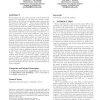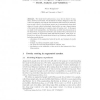126
Voted
JCP
2008
15 years 1 months ago
2008
In order to implement both the efficiency and security in the Peer-to-Peer (P2P) network, we design a trusted small world overlay P2P network with the role based and reputation bas...
93
Voted
IJCAI
2001
15 years 2 months ago
2001
We show that nodes of high degree tend to occur infrequently in random graphs but frequently in a wide variety of graphs associated with real world search problems. We then study ...
87
Voted
LWA
2004
15 years 2 months ago
2004
In this paper, we demonstrate how small worlds
121
Voted
HT
2010
ACM
15 years 3 months ago
2010
ACM
We investigate the use of autonomically created small-world graphs as a framework for the long term storage of digital objects on the Web in a potentially hostile environment. We ...
90
Voted
ERCIMDL
1999
Springer
15 years 5 months ago
1999
Springer
I show that the World Wide Web is a small world, in the sense that sites are highly clustered yet the path length between them is small. I also demonstrate the advantages of a sear...
91
Voted
JSAI
2001
Springer
15 years 5 months ago
2001
Springer
The small world topology is known widespread in biological, social and man-made systems. This paper shows that the small world structure also exists in documents, such as papers. A...
98
Voted
INFOVIS
2003
IEEE
15 years 6 months ago
2003
IEEE
Many networks under study in Information Visualization are “small world” networks. These networks first appeared in the study social networks and were shown to be relevant mod...
133
Voted
PODC
2005
ACM
15 years 6 months ago
2005
ACM
We consider four problems on distance estimation and object location which share the common flavor of capturing global information via informative node labels: low-stretch routin...
116
Voted
ESA
2007
Springer
15 years 7 months ago
2007
Springer
Abstract. The small world phenomenon, a.k.a. the six degree of separation between individuals, was identified by Stanley Milgram at the end of the 60s. Milgram experiment demonstr...





